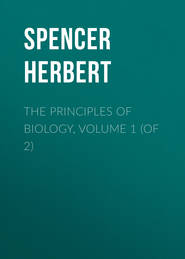По всем вопросам обращайтесь на: info@litportal.ru
(©) 2003-2024.
✖
Essays: Scientific, Political, and Speculative, Volume II
Настройки чтения
Размер шрифта
Высота строк
Поля
• and are fluid. (Hydrostatics.)
• that are not in equilibrium relatively to other masses
• and are solid. (Dynamics.)
• and are fluid. (Hydrodynamics.)
• in molecules (MOLECULAR MECHANICS)
• when in equilibrium: (Molecular Statics)
• giving statical properties of matter
• general, as impenetrability or space-occupancy.
• special, as the forms resulting from molecular equilibrium.
• giving statico-dynamical properties of matter (cohesion, elasticity, etc.)
• when solid.
• when liquid.
• when gaseous.
• when not in equilibrium: (Molecular Dynamics)
• as resulting in a changed distribution of molecules
• which alters their relative positions homogeneously
• causing increase of volume (expansion, liquefaction, evaporation).
• causing decrease of volume (condensation, solidification, contraction).
• which alters their relative positions heterogeneously (Chemistry)
• producing new relations of molecules (new compounds).
• producing new relations of forces (new affinities).
• as resulting in a changed distribution of molecular motion,
• which, by integration, generates sensible motion.
• which, by disintegration, generates insensible motion, under the forms of {Heat.Light.Electricity.Magnetism.}
We come now to the third great group. We have done with the Sciences which are concerned only with the blank forms of relations under which Being is manifested to us. We have left behind the Sciences which, dealing with Being under its universal mode, and its several non-universal modes regarded as independent, treat the terms of its relations as simple and homogeneous; which they never are in Nature. There remain the Sciences which, taking these modes of Being as they are habitually connected with one another, have for the terms of their relations, those heterogeneous combinations of forces that constitute actual phenomena. The subject-matter of these Concrete-Sciences is the real, as contrasted with the wholly or partially ideal. It is their aim, not to separate and generalize apart the components of all phenomena, but to explain each phenomenon as a product of these components. Their relations are not, like those of the simplest Abstract-Concrete Sciences, relations between one antecedent and one consequent; nor are they, like those of the more involved Abstract-Concrete Sciences, relations between some few antecedents cut off in imagination from all others, and some few consequents similarly cut off; but they are relations each of which has for its terms a complete plexus of antecedents and a complete plexus of consequents. This is manifest in the least involved Concrete Sciences. The astronomer seeks to explain the Solar System. He does not stop short after generalizing the laws of planetary movement, such as planetary movement would be did only a single planet exist; but he solves this abstract-concrete problem, as a step towards solving the concrete problem of the planetary movements as affecting one another. In astronomical language, “the theory of the Moon” means an interpretation of the Moon’s motions, not as determined simply by centripetal and centrifugal forces, but as perpetually modified by gravitation towards the Earth’s equatorial protuberance, towards the Sun, and even towards Venus: forces daily varying in their amounts and combinations. Nor does the astronomer leave off when he has calculated what will be the position of a given body at a given time, allowing for all perturbations; but he goes on to consider the effects produced by reactions on the perturbing masses. And he further goes on to consider how the mutual perturbations of the planets cause, during a long period, increasing deviations from a mean state; and then how compensating perturbations cause continuous decrease of the deviations. That is, the goal towards which he ever strives, is a complete explanation of these complex planetary motions in their totality. Similarly with the geologist. He does not take for his problem only those irregularities of the Earth’s crust that are worked by denudation; or only those which igneous action causes. He does not seek simply to understand how sedimentary strata were formed; or how faults were produced; or how moraines originated; or how the beds of Alpine lakes were scooped out. But taking into account all agencies co-operating in endless and ever-varying combinations, he aims to interpret the entire structure of the Earth’s crust. If he studies separately the actions of rain, rivers, glaciers, icebergs, tides, waves, volcanoes, earthquakes, etc.; he does so that he may be better able to comprehend their joint actions as factors in geological phenomena: the object of his science being to generalize these phenomena in all their intricate connexions, as parts of one whole. In like manner Biology is the elaboration of a complete theory of Life, in each and all of its involved manifestations. If different aspects of its phenomena are investigated apart – if one observer busies himself in classing organisms, another in dissecting them, another in ascertaining their chemical compositions, another in studying functions, another in tracing laws of modification; they are all, consciously or unconsciously, helping to work out a solution of vital phenomena in their entirety, both as displayed by individual organisms and by organisms at large. Thus, in these Concrete Sciences, the object is the converse of that which the Abstract-Concrete Sciences propose to themselves. In the one case we have analytical interpretation; while in the other case we have synthetical interpretation. Instead of synthesis being used merely to verify analysis; analysis is here used only to aid synthesis. Not to formulate the factors of phenomena is now the object; but to formulate the phenomena resulting from these factors, under the various conditions which the Universe presents.
This third class of Sciences, like the other classes, is divisible into the universal and the non-universal. As there are truths which hold of all phenomena in their elements; so there are truths which hold of all phenomena in their totalities. As force has certain ultimate laws common to its separate modes of manifestation, so in those combinations of its modes which constitute actual phenomena, we find certain ultimate laws that are conformed to in every case. These are the laws of the re-distribution of force. Since we can become conscious of a phenomenon only by some change wrought in us, every phenomenon necessarily implies re-distribution of force – change in the arrangements of matter and motion. Alike in molecular movements and the movements of masses, one great uniformity may be traced. A decreasing quantity of motion, sensible or insensible, always has for its concomitant an increasing aggregation of matter; and, conversely, an increasing quantity of motion, sensible or insensible, has for its concomitant a decreasing aggregation of matter. Give to the molecules of any mass, more of that insensible motion which we call heat, and the parts of the mass become somewhat less closely aggregated. Add a further quantity of insensible motion, and the mass so far disintegrates as to become liquid. Add still more insensible motion, and the mass disintegrates so completely as to become gas; which occupies a greater space with every extra quantity of insensible motion given to it. On the other hand, every loss of insensible motion by a mass, gaseous, liquid, or solid, is accompanied by a progressing integration of the mass. Similarly with sensible motions, be the bodies moved large or small. Augment the velocities of the planets, and their orbits will enlarge – the Solar System will occupy a wider space. Diminish their velocities, and their orbits will lessen – the Solar System will contract, or become more integrated. And in like manner we see that sensible motions given to bodies on the Earth’s surface involve partial disintegrations of the bodies from the Earth; while the loss of their motions are accompanied by their re-integration with the Earth. In all changes we have either an integration of matter and concomitant dissipation of motion; or an absorption of motion and concomitant disintegration of matter. And where, as in living bodies, these processes go on simultaneously, there is an integration of matter proportioned to the dissipation of motion, and an absorption of motion proportioned to the disintegration of matter. Such, then, are the universal laws of that re-distribution of matter and motion everywhere going on – a re-distribution which results in Evolution so long as the aggregation of matter and dispersion of motion predominate; but which results in Dissolution where there is a predominant aggregation of motion and dispersion of matter. Hence we have a division of Concrete Science which bears towards the other Concrete Sciences, a relation like that which the Universal Law of Relation bears to Mathematics, and like that which Universal Mechanics (composition and resolution of forces) bears to Physics. We have a division of Concrete Science which generalizes those concomitants of this re-distribution that hold good among all orders of concrete objects – a division which explains why, along with a predominating integration of matter and dissipation of motion, there goes a change from an indefinite, incoherent homogeneity, to a definite, coherent heterogeneity; and why a reverse re-distribution of matter and motion, is accompanied by a reverse structural change. Passing from this universal Concrete Science, to the non-universal Concrete Sciences; we find that these are primarily divisible into the science which deals with the re-distributions of matter and motion among masses in space, consequent on their mutual actions as wholes; and the science which deals with the re-distributions of matter and motion consequent on the mutual actions of the parts of each mass. And of these equally general Sciences, this last is re-divisible into the Science which is limited to the concomitants of re-distribution among the parts of each mass when regarded as independent, and the Science which takes into account the molecular motion received by radiation from other masses. But these sub-divisions, and their sub-sub-divisions, will be best seen in the annexed Table III.
• TABLE III.
• CONCRETE SCIENCE.
• Universal laws of the continuous re-distribution of Matter and Motion; which results in Evolution where there is a predominant integration of Matter and dissipation of Motion, and which results in Dissolution where there is a predominant absorption of Motion and disintegration of Matter.
• Laws of the redistributions of Matter and Motion actually going on
• among the celestial bodies in their relations to one another as masses: comprehending (ASTRONOMY)
• the dynamics of our solar system. (Planetary Astronomy.)
• the dynamics of our stellar universe. (Sidereal Astronomy.)
• among the molecules of any celestial mass; as caused by
• the actions of these molecules on one another (ASTROGENY)
• resulting in the formation of compound molecules. (SolarMineralogy.)
• resulting in molecular motions and genesis of radiant forces.[9 - This must not be supposed to mean chemically-produced forces. The molecular motion here referred to as dissipated in radiations, is the equivalent of that sensible motion lost during the integration of the mass of molecules, consequent on their mutual gravitation.]
• resulting in movements of gases and liquids. (SolarMeteorology.[10 - Embracing the interpretation of such phenomena as the solar spots, the faculæ and the coronal flames.])
• the actions of these molecules on one another, joined with the actions on them of forces radiated by the molecules of other masses: (GEOGENY)
• as exhibited in the planets generally.
• as exhibited in the Earth
• causing composition and of decomposition of inorganic matters. (Mineralogy.)
• causing re-distributions of gases and liquids. (Meteorology.)
• causing re-distributions of solids. (Geology.)
• causing organic phenomena; which are (Biology)
• those of structure (Morphology)
• general.
• special.
• those of function
• in their internal relations (Physiology)











